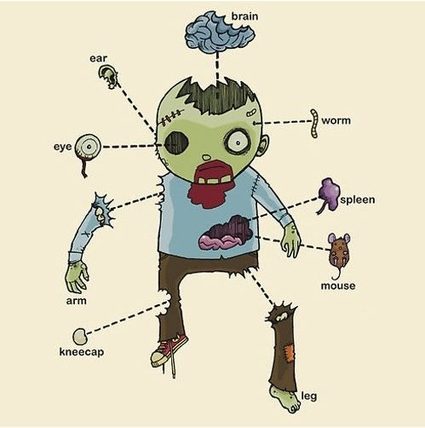Zombie Invasion Calculator
You might be wondering if brain-eating monsters and the walking dead are just pieces of fiction. That virus outbreaks are something so unlikely they belong to the spookiness for Halloween. You're absolutely right, zombies don't exist. But let's say this was all true. What if the world was taken over by a virus, forcing people to quarantine themselves. Nobody's allowed to travel anywhere, and worst of it all - toilet paper is rationed. Would you still not be scared?
News Update: The virus may have resurrected the undead, and now they're coming after you. Are you ready? Don't worry. We took a chance and made this zombie invasion calculator to help you create an escape plan. In this story, you'll understand the math behind zombie outbreaks, read how to use this zombie invasion model tool, what to watch out for, and why you should be really, really scared.
PS. Happy Halloween 🎃👻
What are zombies?
In a nutshell, a zombie is usually a decaying human corpse that has reawakened from sleep with one goal - to seek and eat brains (most probably because it doesn't have its own 🧠) or other parts of the human body. Reanimation of this creature from the grave involves magic in many cases. Sometimes new zombies arise by spreading an unknown virus or scientific accidents with chemical compounds or radiation. Sometimes we refer to zombies as infected, whose bites can turn a human into another zombie.
It may be surprising, but zombies have a ! Archaeologists found many ancient Greek graves with skeletons pinned down by rocks or other heavy objects, suggesting that people wanted to prevent the dead bodies from reanimating. However, the term zombie comes from Haitian folklore, which means an . Right now, we sometimes refer to people as "zombies" when they seem only partially alive, without any feeling or interest in what is happening.
Zombies appear in literature, movies, and games. The earliest book with the word "zombie" in Le Zombi du grand Pérou. In modern pop culture, there are now hundreds of stories about zombies. We decided to include in the calculator some of the characters from our favorite movies:
- Resident Evil
- The Last of Us
- Zombieland
- I am Legend
- Shaun of the Dead
- World War Z
- Dawn of the Dead
- 28 Days Later
- Maggie
- Train to Busan
- Thriller

Simulating zombie outbreak
On the Internet, you can find many tools that allow you to simulate a zombie outbreak. Most of the available tools base their results on the SIR model (Susceptible, Infected, Recovered) or the predator-prey model. To discover these models, visit Omni's SIR calculator and humans vs vampires calculator, respectively.
We use them to solve problems with time-dependent population dynamics.
The zombie invasion calculator uses a similar approach, we called zombie invasion model, but in a more controllable manner. We simulate the changes in two populations (humans and zombies) day by day with various mutual interactions between these two groups. In our opinion, the best movies are those with an unexpected turn of events. That's why we added a little bit of randomness. It's best to check it with an initial number of zombies equal to one - in some cases, humans will kill this one lonely zombie immediately, but in others, a zombie will infect enough people to keep the invasion going forward. The start is a critical moment!
How does the zombie invasion calculator work?
If you have any doubts about using the calculator, let's go swiftly through some instructions.
Begin with the parameters at the top of the calculator and go to the bottom. If you feel that you would like to change the value we set as default, don't hesitate and do it! We divided the zombie invasion calculator into two tabs:
-
Humans — a group of people that fight for their lives with zombies. You can set:
-
Initial number of humans — is it a small town with 10,000 citizens or the most populous US city, New York, with a population of 8,350,000?
-
Human defense stance — determines how a human behaves when they meet a zombie. If you want to avoid an encounter, select flee, but if you want to get rid of the zombies, then fight is a better option.
-
Human fighting skills — is the field in which you can determine how many zombies can a single human kill on average. We include here some of the characters from zombie movies.
-
-
Zombies — always hungry creatures that seek human's fresh meat to eat and infect others by biting. For them, you can set:
-
Initial number of zombies — observe how an epidemic spreads from a small group of zombies or put a whole horde of zombies versus humans at the very beginning.
-
Transformation probability — as we all know, zombies can turn people into other zombies by biting, but it doesn't need to be a thing in every case. So, what's the probability that an attacked human turns into a zombie?
-
Zombie attack frequency — how often does a zombie meet a human? Remember that this field concerns only one zombie. We take into account the current number of zombies automatically.
-
Zombie resurrection rate — zombies are scary enemies that can be shoot or cut and could still walk on as nothing happened. Even if we think that they already died, they might stand up again. For this case, we allowed you to set the zombie resurrection rate as a percentage.
-
Zombie speed — as we all know, zombies in the movies are crawling really slowly. But does it always have to be like that? You decide!
-
Can zombies starve to death? — that's an important field. You can say that all zombies can live without human flesh forever (i.e., zombies won't starve to death) or die if there is not enough food for them.
-
As a result, you will obtain a chart showing population changes amongst humans (blue curve) and zombies (red curve). The x-axis is the number of days passed since the beginning of the outbreak, and the y-axis represents the number of humans and zombies.
You can simulate many different scenarios with this zombie invasion model! Will humanity overpower the hordes of zombies under your command? ⭐
The zombie invasion model algorithm
We prepared this section to understand the zombie invasion calculator functionality. In this algorithm, we're simulating the interaction between human and zombie populations day by day. Firstly, we set the initial number of humans and zombies. Then for each day, we calculate:
-
The number of attacks by zombies:
number of attacks = number of zombies × attack frequencyIf the
number of attacksis too large, then instead, we calculate it as:number of attacks = number of humans × 5which means that each human can be attacked up to 5 times a day.
-
The number of flees and fights:
number of flees = number of attacks × human defense stancewhere
human defense stancedetermines how many people try to escape when meeting a zombie (in %). The rest of the people fight with zombies:number of fights = number of attacks - number of flees -
Humans deaths:
humans deaths = unsuccessful flees + fights won by zombiesIf the number of human deaths exceeds humans' current number, we naturally set the number of humans to zero. The two values on the right-hand side of the equation are:
unsuccessful flees = number of flees × zombie speedwith
zombie speedexpressed in percentages (if zombie speed is 100%, then no human can escape a zombie), and:fights won by zombies = number of fights × (1 − human fighting skills)The
human fighting skillsshould be, again, expressed in percentages. -
New zombies:
new zombies = human deaths × human transformation probability -
Zombies deaths:
zombies deaths = deaths in fight + deaths due to starvingwhere:
deaths in fight = fights won by humans × (1 − zombie resurrection rate)for which
fights won by humansis just the difference between thenumber of fightsandfights won by zombies. On the other hand, thezombie resurrection rate, expressed in percentages, tells you how many zombies stand up alive after lethal injuries. The second variable:deaths due to starving = (number of zombies - humans deaths) × zombie starvation ratedetermines how many zombies died due to lack of food. You can decide how many starving zombies die by setting the
zombie starvation ratefield (in %). -
Modify the current populations:
new number of humans = number of humans − humans deathsnew number of zombies = number of zombies − zombies deaths + new zombies
That's our whole algorithm we're repeating (steps 1-6) each day until one of the populations becomes very small (less than 0.01% of the initial value).
As we mentioned before, we also added a small element of randomness. How does it work? Well, we don't round the above intermediate results typically, but rather to a random nearest integer. For example, if we get new zombies = 0.35, it can be either rounded to 0 or 1.
The Zombie Survival Guide
How to survive a zombie invasion? Although we haven't had an opportunity to fight a horde of zombies (thankfully!), people already created many strategies and guides about it. by Max Brooks that covers everything you should know about zombies (their psychology and behavior) and the most effective defense tactics and weaponry.
Here are some of the most common found on the Internet:
-
Never turn your back on zombies. They might be crawling very slowly, but their surprise attack may be deadly.
-
Protect yourself. You probably won't know what caused the transformation of people into zombies. So, find a mask that covers your mouth and nose (sounds familiar? 😷), grab some gloves and a hazmat suit. If you don't find them, then find whatever you can to cover up.
-
Choose your weapons. Melee weapons are fine unless you take a giant hammer, which requires a lot of time to swing. Instead, use a machete, which is cheap, lightweight, and separates a zombie body parts. If you decide to use range weapons, a shotgun or bolt action rifles are an excellent choice.
-
Watch out for the other people. Knowing you're not alone but with allies helps a lot for your psyche. It's always good to stay in a group and support each other. On the other hand, a human can become even more deadly than zombies in the lawless world, so don't trust everyone!
-
Gather supplies and find transportation. You would need first aid supplies, lighters, sleeping bags, and other survival items. As for the ride, it's good to have a car or a bike to escape quickly from the horde of zombies.
Zombies in the real world
It turns out that the undead are not just confined to the world of fictional creatures. There are a few examples of . One species of fungi infects various insects, taking control of their mind. This fungus especially attaches to ants and grows into and out of a zombie ant's body until it dies.
The other example is zombie spiders. Scientists that the Zatypota wasp lays an egg with larva on an A. eximus spider's abdomen, which then hatches, starts feeding on the spider and gains full control of it. This zombie-like creature is forced to spin the cocoon-like nest that allows the larva to turn into the adult wasp.
Watch this video if you're strong enough. It's so creepy!
